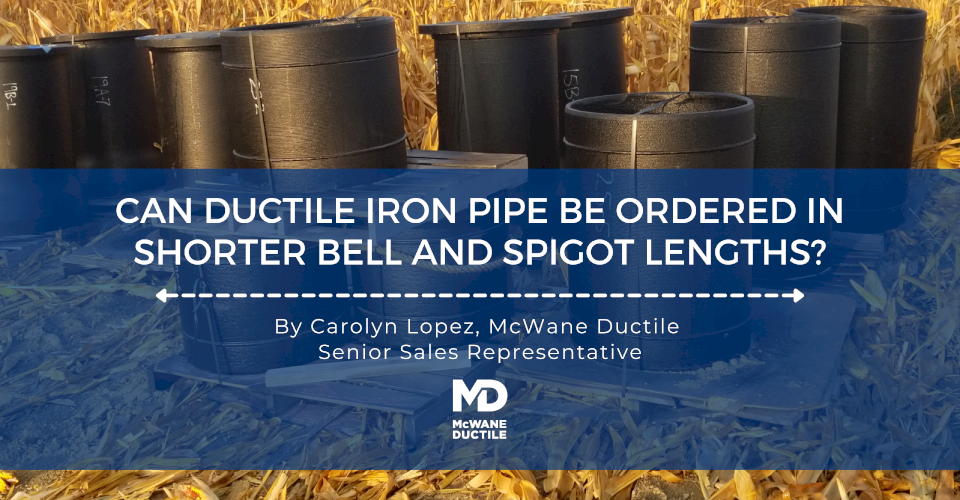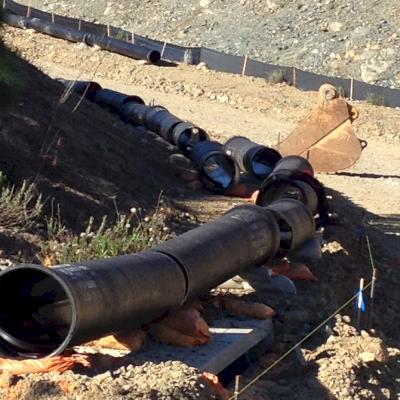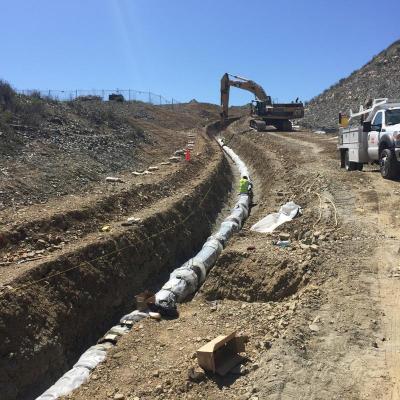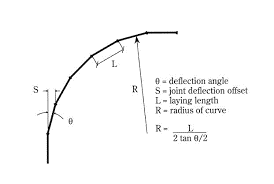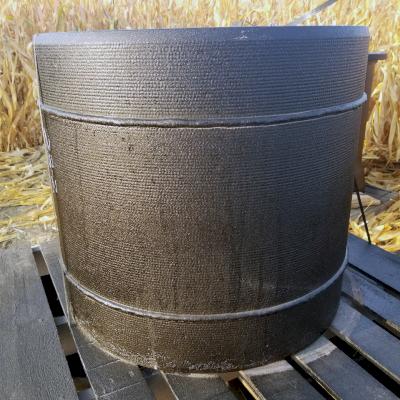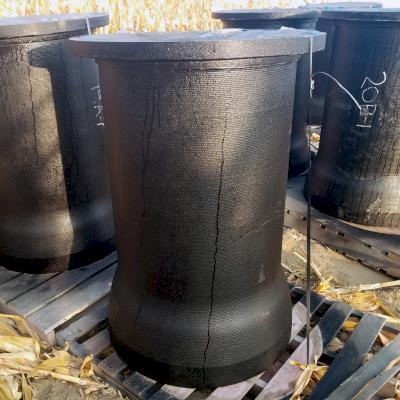Have you ever wondered or asked if it is possible to order shorter lengths of bell and spigot Ductile iron pipe (DI pipe) for your waterworks project or sections within it? The answer is YES; we can help you with those shorter lengths of DI pipe for your project.
Why Use Shorter Bell and Spigot Lengths?
The short lengths of bell and spigot DI pipe or cut sections, as they are also referred to, are often used to achieve the desired curve or bend along the pipeline within the project. In some cases, this can help reduce the number of fittings required to make the curve or bend.
The project design may call for a fitting of 11 ¼ or 22 ½ degrees. Five TR Flex® joints deflected to 5 degrees provide more radius or deflection than the 22 ½ degree fitting which will require restraint on both sides of the fitting. The TR Flex pipe provides the restraint plus the angle of deflection. Utilizing pipe at shorter lengths than the nominal 18-foot length also reduces the amount of space required to achieve the overall goal.
Installation time will dramatically be reduced as well. The time to install an 8-inch MJ fitting is approximately an hour (cutting pipe, installing bolts, etc, and connecting on both sides) vs 8-inch TR Flex joints which take approximately one minute to make the joint. Reduced installation requirements ultimately enhance the overall project.
Calculating the Radius of Your Pipeline
With the help of the McWane Pocket Engineer Radius Calculator, the calculations for the radius of your project can be achieved using the Tyton Joint® and TR Flex® pipe with deflection of up to five degrees depending on the size and type of DI pipe used.
Did you know that five degrees of deflection can provide up to 19.1 inches of offset on some full-length pipe? For example, after the joint is properly assembled, you can deflect a full-length piece of 12-inch TR-Flex 19.1 inches in any direction. Within a project, you may also find that shorter length pipe is required, as mentioned by my colleague Jerry Regula, in his Iron Strong Blog, “Key Considerations When Using DI Pipe for Bridge Crossings.” He states that specific laying lengths should be ordered to provide the correct size to correspond with the hanger system.
When using shorter length sections, Sure Stop gaskets can be used with Tyton Joint pipe, or the project may specify TR Flex pipe. In either case, you can also order zinc coated pipe as well as using V-Bio® Enhanced Polyethylene Encasement (V-Bio). V-Bio provided by McWane Ductile is sold in full rolls and is non-perforated; the V-Bio is cut to length as needed reducing waste in the field…only use what you need.
Using Short Pieces of TR Flex® for Restraint Projects
McWane Ductile offers TR Flex pipe and Fittings as well. There are times when a complete restraint system may be required, and TR Flex is an excellent option. The project begins with McWane Technical Services developing the line drawings and lay schedule. Next, TR Flex pipe are cut to specific lengths in the manufacturing facility. This pre-cut process reduces the need for field cuts – also reducing safety hazards, time, and money! TR Flex fitting installation time is also much less than conventional MJ fittings. Taking advantage of pre-cut shorter pieces of TR Flex may be extremely beneficial.
Is Choosing HDPE Over Ductile to Achieve a Tighter Radius a Good Idea?
An installer may lean towards using HDPE for Horizontal Directional Drill projects due to past experience or the potential to achieve a tighter radius. HDPE does, in fact, bend and provide a tighter radius than Ductile iron. However, there are several drawbacks to using HDPE vs. Ductile.
What if the trench is 40 feet deep? Can HDPE stand up to that test? Ductile iron pipe can. Using HDPE for this application would require a significant increase in the wall thickness due to the HDPE lacking Hoop Strength compared to the stronger DI pipe. An increase in the DI pipe's wall thickness would be required compared to a shallower 6-foot bury. However, the increase in wall thickness would be insignificant compared to the HDPE, which would dramatically affect water flow.
The increase in wall thickness would require an increase in the pipe diameter to achieve the same flow rate. An increase in pipe size would then lead to increasing the cost of valves and fittings. Such a small decision can have a significant impact on a project.
Both types of pipe are designed as a flexible conduit. The inherent weakness of HDPE bedding conditions is much more critical than with DI pipe. Proper bedding is required to control the deflection of the HDPE pipe. Because of DI pipes' inherent strength, native trench conditions in accordance with ANSI/AWWA C150/A21.50 are adequate for most applications.
HDPE is also subject to internal deflection caused by a vacuum. Have you ever siphoned water from one vessel to another? A catastrophic failure on the downside stream of a pipeline may create a vacuum that may collapse the HDPE pipe. The HDPE will not return to the original shape. Therefore your 12-inch water line is now an 8-inch and unable to perform as intended. Air release valves are often installed to prevent such a catastrophic failure. Let me ask you a question: Would you rather trust an air release valve or sleep well knowing you installed DI pipe?
Back to the Subject of Radius
Did you know the HDPE requires additional pulling force when the radius of the bore is reduced? The HDPE tends to ride at the top of the bore, increasing the pulling force. A common experience is for the HDPE to stretch during the pull, which will stress the pipe. This pulling stress may also cause the pipe to "shrink" back into the bore one or two days after completion.
We invite you to take advantage of a handy tool for HDD calculations via the McWane Ductile Pocket Engineer calculations to see what may best suit your project is as easy as clicking a few buttons. As you can see, Ductile iron is a superior product on several subjects. Providing shorter lengths of pipe enhances the potential for an already great product.
For more information on the topics we just covered, see these helpful Iron Strong Blogs by my colleagues:
HDPE & DI Pipe – A Comparative Narrative by Ken Rickvalsky
How to Design the Thickness of Ductile Iron Pipe by Mike Palermo
How Does Proper Bedding Allow Pipe to Sleep Well? Coauthored by Gunner Christian & Ken Rickvalsky
How to Order Shorter Pipe
When ordering, the lay length of the shorter length pipe or cut sections is measured from the base of the bell, and the required length will be specified on the purchase order sent for the project from the customer. It then starts as a full-length joint of DI pipe that is cut and beveled to that specific length. In the end, it looks just like a full-length joint of DI pipe, only shorter. And our shipping department provides the same quality of care with the shorter lengths of pipe as when full-length joints are being shipped.
The cost of the shorter length Ductile iron pipe sections will be quoted by your local sales representative specific to your project. The additional work does increase the upfront cost of the pipe, but you will benefit from reduced installation costs by decreasing the potential for injury (field cuts) and equipment costs such as fuel and saw blades, to name a few.
A “Short” Summary
In Summary, short lengths of bell and spigot Ductile iron pipe are often used to achieve the desired curve or bend along the pipeline within many various projects. This can help reduce the number of fittings and help construct a pipeline in a tight area such as a city. If you have any questions regarding DI pipe in shorter lengths or spigots, please contact your local McWane Ductile sales representative. We are here to assist with building your water or wastewater projects.

